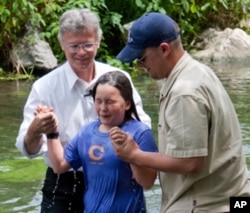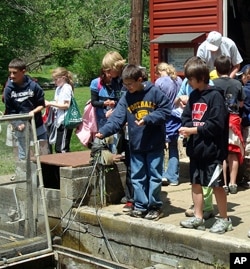On a warm Sunday morning members from Lancaster Evangelical Free Church gather on the wooded banks of Lititz Run. Pastor Doug Winne stands knee-deep in the clear, slow-moving waters, conducting baptisms.
The spring-fed stream in Lancaster County, Pennsylvania, begins its journey in downtown Lititz and weaves under highways, across cow pastures and cornfields carrying polluted runoff from farms, sewage treatment plants, construction sites, driveways, parking lots, and streets to the Chesapeake Bay on America's eastern coast.
Lancaster County, Pennsylvania is growing, but so is pollution of its waterways
According to the Chesapeake Bay Foundation, Lancaster County waterways have some of the highest pollution levels in the entire watershed. Land is used intensively by farmers, manufacturers, tourists and the 500,000 residents who live in Lancaster County, which is the fastest growing county in the state.
Twelve years ago Lititz Run was in poor shape when a group of fishermen with the conservation group Trout Unlimited approached Warwick township manager Dan Zimmerman. Zimmerman's jurisdiction includes Lititz Run. Back then, he says, Lititz Run had only a few scattered Sycamore trees, "There was no protection from the sun. You had erosion of the stream bank. You had the sewage treatment plant discharging into it."
Local fisherman and commercial developers dive in to help clean stream project
The fishermen wanted their trout stream back. Zimmerman was faced with a triple challenge: manage growth, keep farms productive and protect the environment. He says Lititz Run became the focal point for that effort. "We put in a wetlands to treat storm water off the road. We shrank the width of this stream from 50 feet [15.2 meters] to its width about 15 feet [4.5 meters]," Zimmerman says.
Volunteers built a trail system, farmers put conservation plans in place, and township headquarters became a center for residents to learn how to curb runoff from their lawns, driveways and streets. Builders saw the projects as a way to promote business, so they installed grass buffers and porous pavement to absorb rainwater. "I have a lot of developers that exceed the requirements not because we force them, but because they see the whole big picture and want to become part of that and use it as a market tool," Zimmerman says.
Warwick Township has since doubled the size of its wetlands and lowered the water temperature so that it's cold enough for trout to thrive. Zimmerman says the initial goal was to remove Lititz Run from the State's impaired waters list. But now it's about much more. Warwick Township put a value on a clean local environment. Their commitment could inspire others in the watershed to protect their community's natural assets, now and for generations to come.



